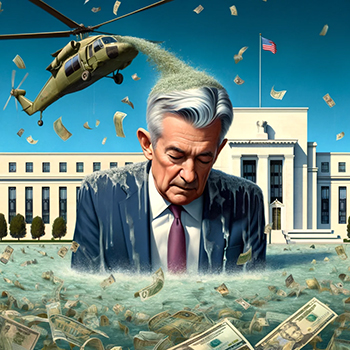
The Federal Reserve is Irrelevant and Ineffective
The role of the Federal Reserve (Fed), the central bank of the United States, is often debated in economic circles. Critics argue that despite its significant influence over monetary policy, the Fed is becoming increasingly irrelevant and ineffective in addressing modern economic challenges. We explore the key reasons why we believe the Fed’s impact on the economy is a joke.
Evolving Economic Landscape
The global economic landscape has undergone significant changes, which have challenged the traditional tools and mechanisms the Fed uses to influence the economy. For instance, the effectiveness of adjusting interest rates to control inflation or stimulate economic growth is questioned in an era where non-traditional financial transactions bypass traditional banking systems.
Limitations of Conventional Tools
The primary tools at the Fed’s disposal—manipulating interest rates and controlling the money supply—seem increasingly blunt in a nuanced economic environment. Post-2008 financial crisis, the Fed’s policy of maintaining near-zero interest rates and engaging in quantitative easing has shown diminishing returns. There’s a growing consensus that these tools may no longer stimulate economic growth as effectively as they once did, especially when interest rates hit the lower bound, limiting the Fed’s ability to use them as levers during economic downturns.
Impact on Inequality
Another criticism of the Fed’s role in the modern economy centers on the distributional effects of its policies. Some argue that the Fed’s actions, particularly quantitative easing, have disproportionately benefited wealthier individuals and corporations, who are more likely to invest in financial markets. This has potentially widened the wealth gap, as lower-income individuals, who are less likely to own stocks or bonds, do not see the same benefits. The perception that the Fed’s policies favor the rich has fueled debates about its relevance and effectiveness in promoting broad-based economic prosperity.
Questionable Independence
The Fed’s independence is crucial for making unbiased policy decisions based on economic data rather than political pressures. However, this independence has come under scrutiny, with critics arguing that the Fed may be too close to Wall Street and large banks, influencing its policies and priorities. This perceived lack of independence undermines its effectiveness and public trust, as decisions may be seen as aligning with the interests of the financial elite rather than the broader economy.
Ineffectiveness in Managing Modern Economic Crises
Recent crises, such as the COVID-19 pandemic, have tested the Fed’s ability to manage economic shocks that are not solely financial in nature but are widespread, affecting supply chains, employment, and health infrastructure. The Fed’s traditional tools are not designed to address such multifaceted crises directly, which highlights its limitations and raises questions about its role in managing modern economic challenges.
While the Federal Reserve has played a central role in shaping U.S. economic policy, there is a growing discourse about its relevance and effectiveness in a rapidly changing global economy. We believe that the Fed’s traditional tools are ill-suited to address new economic realities, potentially making it an outdated institution. As the economic landscape continues to evolve, the debate over the Federal Reserve’s role and effectiveness will likely intensify, prompting calls for a reassessment of its strategies and perhaps even its fundamental purpose.
Why the Federal Reserve is Irrelevant and Ineffective: The Overpowering Impact of Government Fiscal Spending
The Federal Reserve, central to U.S. economic policymaking for over a century, faces increasing scrutiny and criticism regarding its relevance and effectiveness. This article examines how extensive government fiscal spending often undermines the Fed’s attempts to manage economic stability, particularly by using interest rates to control inflation and slow economic growth, highlighting a key aspect where the Fed seems increasingly ineffective.
Dilution of Monetary Policy Impact
Monetary policy, particularly through the manipulation of interest rates, has traditionally been the Federal Reserve’s primary tool for controlling inflation and smoothing out economic cycles. However, in an era of massive government fiscal spending, the potency of this tool is significantly diminished. When the government pumps large amounts of money into the economy—whether through public works, social programs, or other expenditures—the injection can counteract the Fed’s measures aimed at tightening the economy. For instance, even if the Fed raises interest rates to curb inflation, substantial government spending can offset these effects by increasing demand and pushing prices up, thereby fueling inflation rather than cooling it.
Fiscal Dominance Over Monetary Policy
The concept of fiscal dominance suggests that when there is a conflict between monetary and fiscal policies, fiscal policy tends to have the upper hand. In situations where government deficits are financed by borrowing, the pressure to keep interest rates low can become overwhelming to accommodate government debt servicing at sustainable levels. This can leave the Federal Reserve in a precarious position, needing to balance its mandate of controlling inflation and fostering employment against the practical necessities of national fiscal health. As a result, the Fed’s independence can be compromised, reducing its ability to effectively manage the economy.
Economic Stimulus and Inflationary Pressures
Recent decades have seen a shift towards more aggressive fiscal policies as a tool for economic stimulus. The COVID-19 pandemic, for example, prompted unprecedented levels of government spending worldwide, including the United States. While such measures are crucial in times of crisis, they can create lasting inflationary pressures that are difficult for the Federal Reserve to manage through traditional monetary tools. This scenario often leaves the Fed chasing inflation rather than preempting it, questioning the effectiveness and timeliness of its interventions.
Inadequacy in Addressing Modern Economic Challenges
The challenges of modern economies—globalized markets, technological disruptions, and complex supply chain issues—are increasingly out of reach of the tools available to the Federal Reserve. The scope and scale of fiscal interventions can overshadow the subtler adjustments possible through monetary policy. Moreover, in a politically charged environment, the push for immediate relief through fiscal spending often gains more traction than the longer-term strategies typically favored by the Fed, rendering its actions less relevant to immediate economic conditions.
The relevance and effectiveness of the Federal Reserve are being questioned in an age where government fiscal policies frequently overshadow traditional monetary policy tools. As government spending continues to grow, often for necessary and immediate economic stabilization, the ability of the Federal Reserve to manage economic outcomes effectively with its traditional toolkit is increasingly in doubt. This dynamic calls for a reassessment of the roles and tools of the Fed, possibly pointing towards a future where fiscal and monetary coordination is more integrated and strategically aligned to meet the complex challenges of today’s global economy.
Structural Changes in the Economy and Policy Response
As the global economy evolves, the structure of economic activities also shifts, impacting how effective the Federal Reserve’s policies can be. The transition from a manufacturing-based to a service-oriented economy, for example, affects economic sensitivity to interest rate changes. Service industries, which now dominate the U.S. economy, may not respond to monetary policy adjustments in the same way that manufacturing sectors once did. This structural shift reduces the effectiveness of traditional monetary tools like interest rate adjustments, further complicating the Fed’s task.
Global Financial Influence and Limitations
The increasing globalization of financial markets also poses significant challenges to the Federal Reserve’s effectiveness. Capital flows that cross national boundaries can dilute the impact of domestic monetary policy. For instance, if the Fed raises interest rates to cool off the economy and curb inflation, foreign investors might see this as an opportunity to invest in U.S. assets, leading to an inflow of capital that counteracts the tightening effect intended by the Fed. This global interconnectivity demands a more nuanced approach to policy that considers international as well as domestic impacts.
Technological Advancements and Monetary Policy
Technological advancements, particularly in digital currencies and fintech, are also rendering traditional monetary control mechanisms less effective. With the rise of cryptocurrencies and other digital payment systems, more transactions can occur outside the traditional banking system, which the Federal Reserve regulates. This development could diminish the Fed’s control over the money supply and, by extension, inflation and economic growth, challenging its ability to implement effective monetary policies.
Political Implications and Policy Effectiveness
Political influences often complicate the Federal Reserve’s operations. While designed to be an independent entity, political pressures can influence its policy decisions, especially during periods of economic stress. These pressures can lead to decisions that prioritize short-term political gains over long-term economic stability, undermining the effectiveness of the Fed’s policies and possibly leading to greater economic volatility.
The Need for a New Approach
Given these myriad challenges, there is a growing recognition that a more holistic approach may be required, one that involves better coordination between monetary and fiscal policies. To regain relevance and effectiveness, the Federal Reserve might need to collaborate more closely with other government agencies and align its goals with broader economic policies. This would help in addressing the complex and interrelated challenges of modern economies, ensuring that monetary policy complements rather than conflicts with fiscal initiatives.
The Federal Reserve’s traditional tools and independent role are being tested by a rapidly changing economic landscape. The overpowering influence of expansive fiscal policies, structural economic changes, global financial integration, technological advancements, and political pressures are all factors that challenge its relevance and effectiveness. As such, rethinking and possibly redefining the Fed’s role and strategies in this new economic era may be essential to ensure it can continue to contribute effectively to U.S. economic stability and growth.


